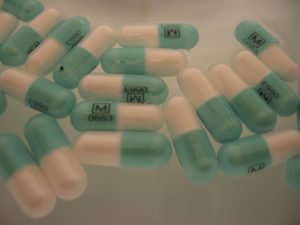
As I’ve written on this website previously, the prescription of antidepressants for children and adolescents is controversial, with warnings being issued relating to a possible paradoxical increase in suicidal thought and behaviour following prescription. However, experiences of low mood and depression for young people remain common, affecting approximately 1 in 20 adolescents at any given time.
Most clinical guidelines now recommend psychological therapies as the first point of treatment for depression in children, but waiting lists for therapies are often long or in some cases they are simply not available. The demand to provide urgent support and relief of distress is strong and understandable, therefore antidepressant drugs can often seem like a good option to reach for. Are we justified in prescribing such treatment? If so, which of the many drugs available should be offered?

With access to talking treatments such a lottery, should we give depressed young people antidepressants instead?
Aims
This question of antidepressant superiority was addressed in a recent network meta-analysis reported by Cipriani and colleagues in which they sought to:
…comprehensively compare and rank antidepressants for the acute treatment of major depressive disorder in children and adolescents.
Methods
Network meta-analysis represents a powerful inferential statistical approach whereby the findings from previous clinical trials can be combined together in a comparative manner to generate cross comparison between various treatments. In this way it is possible to generate ‘hierarchies’ of treatments, on the basis of available evidence, relating to outcomes such as treatment response, or adverse event rates.
The authors therefore began their study by identifying pertinent literature relating to the efficacy of various antidepressant drugs for the treatment of depression in childhood and adolescence (e.g. Fluoxetine, Venlafaxine, Mirtazapine, Citalopram etc).
Outcome measures
For their primary outcome measures the authors considered:
- Change in depressive symptoms (on a validated measure for depression in children and adolescents)
- Discontinued treatment owing to any adverse events
Secondary outcome measures considered included:
- Response rates (either proportion of the trial population achieving a 50% reduction in symptoms, or a change of ‘much’ or ‘very much’ improved on the Clinical Global Impression Scale)
- All cause discontinuation
- Suicidal behaviour or ideation
Statistical analysis
Outcomes were expressed either as standardised mean difference (continuous outcomes, e.g. symptom severity) or odds ratios (categorical outcomes, e.g. discontinued treatment). 95% credible intervals were then calculated for each measure. Variation between outcomes was assessed using a measure of heterogeneity (the difference between varying trial findings) and finally the presence of publication bias was appraised using a visual inspection of trial findings within a funnel-plot.
Outcome measures were then compared through a network meta-analysis process to generate a hierarchical comparison of the drugs.
Results
- The authors identified 31 publications describing 34 randomised controlled trials of 14 different antidepressant drugs
- These trials considered a total of 3,106 participants receiving antidepressants vs 2,154 receiving placebo
- Approximately half of trial participants were female (53%) and the average age was 13.6 years
- The median duration of acute treatment was 8 weeks
- In terms of methodological quality, most identified trials were graded as being of low, or very low quality, and at high risk of bias
- The I2 heterogeneity scores were 33·21% for efficacy and 0% for tolerability (I2 values are low – 25%, moderate – 50% and high – 75%).
Antidepressant efficacy and adverse events
- Of all the reviewed antidepressants, only Fluoxetine achieved statistically significant superiority over placebo in terms of efficacy. This finding was associated with a wide credible interval (standardised mean difference -0·51, 95% credible interval [CrI] -0·99 to -0·03), that came close to the point of no-effect (0.0) raising concerns over the clinical significance of the observation
- In terms of hierarchy therefore, Fluoxetine was rated as superior to other antidepressants in terms of efficacy and tolerability
- Venlafaxine was associated with a statistically significant increase in suicidal ideation and behaviour in comparison with placebo and other antidepressants.

Fluoxetine came out best in this review, but there remains considerable doubt about the clinical significance of these findings.
Discussion
The authors conclude:
When considering the risk-benefit profile of antidepressants in the acute treatment of major depressive disorder, these drugs do not seem to offer a clear advantage for children and adolescents. Fluoxetine is probably the best option to consider when a pharmacological treatment is indicated.
Implications
As an accompanying editorial (Jureidini, 2016) to this research states the findings have:
…disturbing implications for clinical practice, concluding as it does that the risk-benefit profile of antidepressants in the acute treatment of depression does ‘not seem to offer a clear advantage for children and adolescents.’
Both the authors of the main review, and the accompanying editorial, suggest that even the findings relating to Fluoxetine should be interpreted with caution as the clinical significance is unclear, and other, unmeasured, factors may be present that favour the medication outcome within poor quality randomised control trials.
This review therefore implies that any prescribing of antidepressants for young people must be conducted in a particularly careful manner; with close attention to psychosocial supporting work alongside the prescription and awareness for the development of any adverse effects or emergent suicidal ideation.

Time to stop prescribing antidepressants to young people with depression? Please share your views in a comment below.
Links
Primary paper
Cipriani, A., Zhou, X., Del Giovane, C., Hetrick, S. E., Qin, B., Whittington, C., et al. (2016). Comparative efficacy and tolerability of antidepressants for major depressive disorder in children and adolescents: a network meta-analysis. Lancet, 388(10047), 881–890. http://doi.org/10.1016/S0140-6736(16)30385-3
Other references
Jureidini, J. (2016). Antidepressants fail, but no cause for therapeutic gloom. Lancet, 388(10047), 844–845. http://doi.org/10.1016/S0140-6736(16)30585-2


@Mental_Elf Should have been prohibited years ago @EsthervanFenema
.@Mental_Elf @shrinking81
“The Lost Children”
https://t.co/j9pdJIxDDn and
https://t.co/bRgS41FL0y
Thanks for your interest in our work. Our network meta-analysis compared pharmacological agents for major depression. Notwithstanding the wide CI for fluoxetine, our clinical interpretation was that there was still robust evidence to support the utility of this drug in this. We mentioned psychological treatments only in the discussion to place our findings within a broader clinical context and that of international clinical guidelines. As antidepressants and all other active drugs, we know that psychotherapies may have negative side effects. We plan to properly address the issue of comparative effectiveness between pharmacological and non-pharmacological interventions in our next network meta-analysis.
P.S. In our analysis of the primary efficacy outcome the point of no-effect is 0.0 (and not 1.0, as wrongly reported in the comment above). Please, amend this typo.
Don’t miss:
Time to stop prescribing #antidepressants to young people with #depression?
https://t.co/fsuYrF3OMG https://t.co/cX8rcmU4qo
Time to stop prescribing antidepressants to young people with depression? https://t.co/DYicjk9NOD
Time to stop prescribing antidepressants to young people with depression? @AnnYork @annamoore1978 @joan_myers https://t.co/a9EaQCs2QZ
Revisiting recent study on the effectiveness of antidepressants for children & young people https://t.co/tg6Zy0H5T7
Time to stop prescribing antidepressants to young people with depression? https://t.co/cD4HKiHknw via @sharethis
Time to stop prescribing antidepressants to young people with depression? https://t.co/A5BrY5TLPj via @mental_Elf
RT @Mental_Elf: Morning @And_Cipriani We’ve (finally) blogged about your antidepressants in children NMA from @TheLancet https://t.co/fsuYr…
[…] Time to stop prescribing antidepressants to young people with depression? […]
I think the message is clear … https://t.co/Q4GBeP2bwJ
Most popular blog last week?
Time to stop prescribing antidepressants to young people with depression?… https://t.co/UxqEFLqEwJ
Time to stop prescribing antidepressants to young people with depression? #depression #antidepressants #YoungPeople https://t.co/mUs5sgbHMg
Time to stop prescribing antidepressants to young people with depression? https://t.co/kba4FoUqyQ
Time to stop prescribing antidepressants to young people with depression? https://t.co/a5VjFXljok via @sharethis
https://t.co/9RAds4mgHD. prescription of antidepressants for children and adolescents is controversial #suicide @ProfLAppleby #psychology
As a dramatherapist I would always strongly recommend engaging the child in the creative arts therapies in the first instance. Psychologically speaking they are so accessible to this client group, if only the government could see it this way and consider funding & promotion.